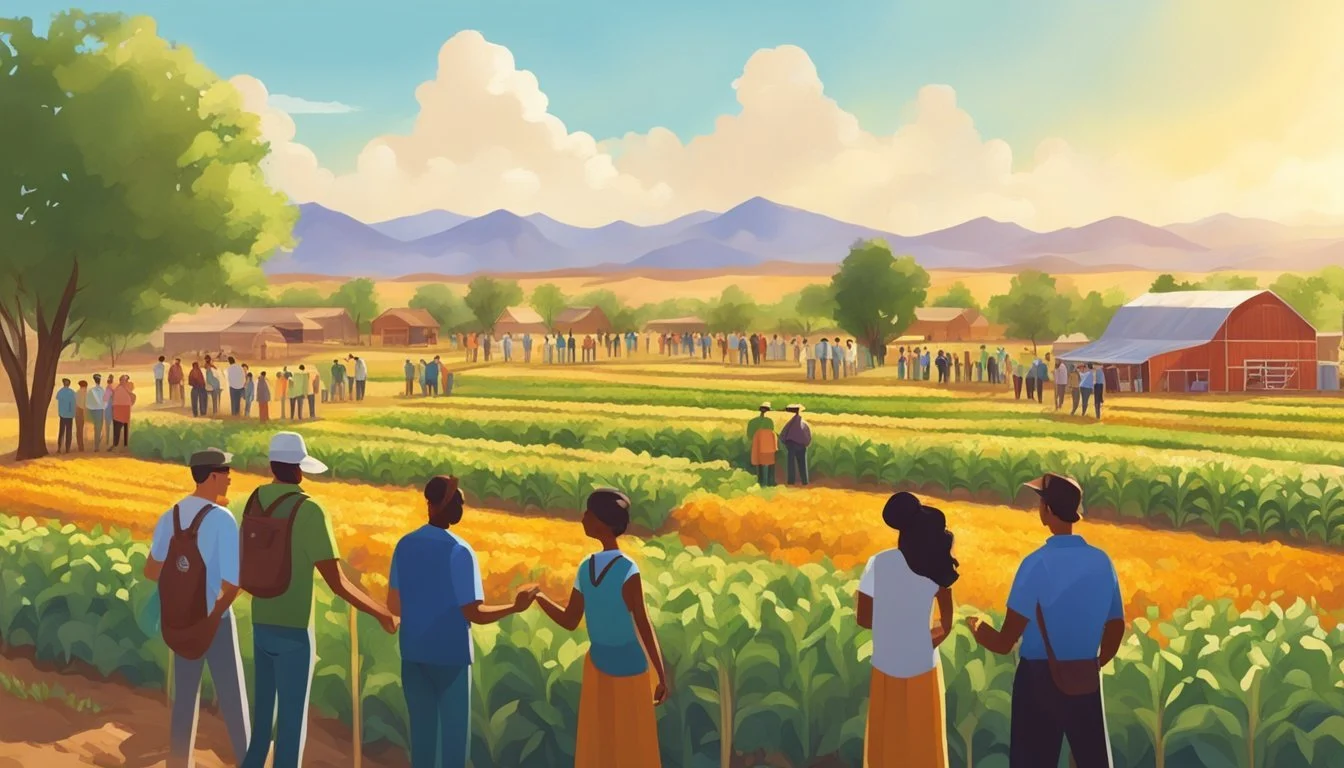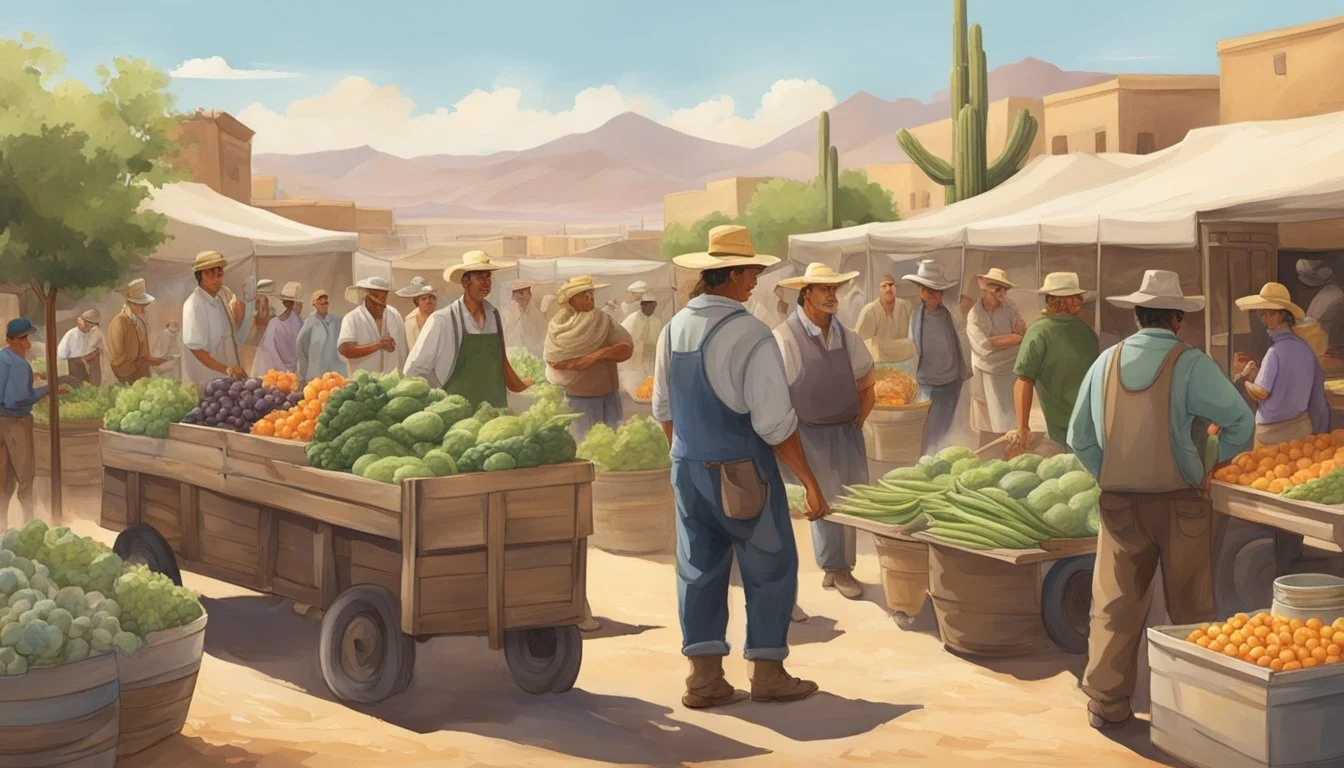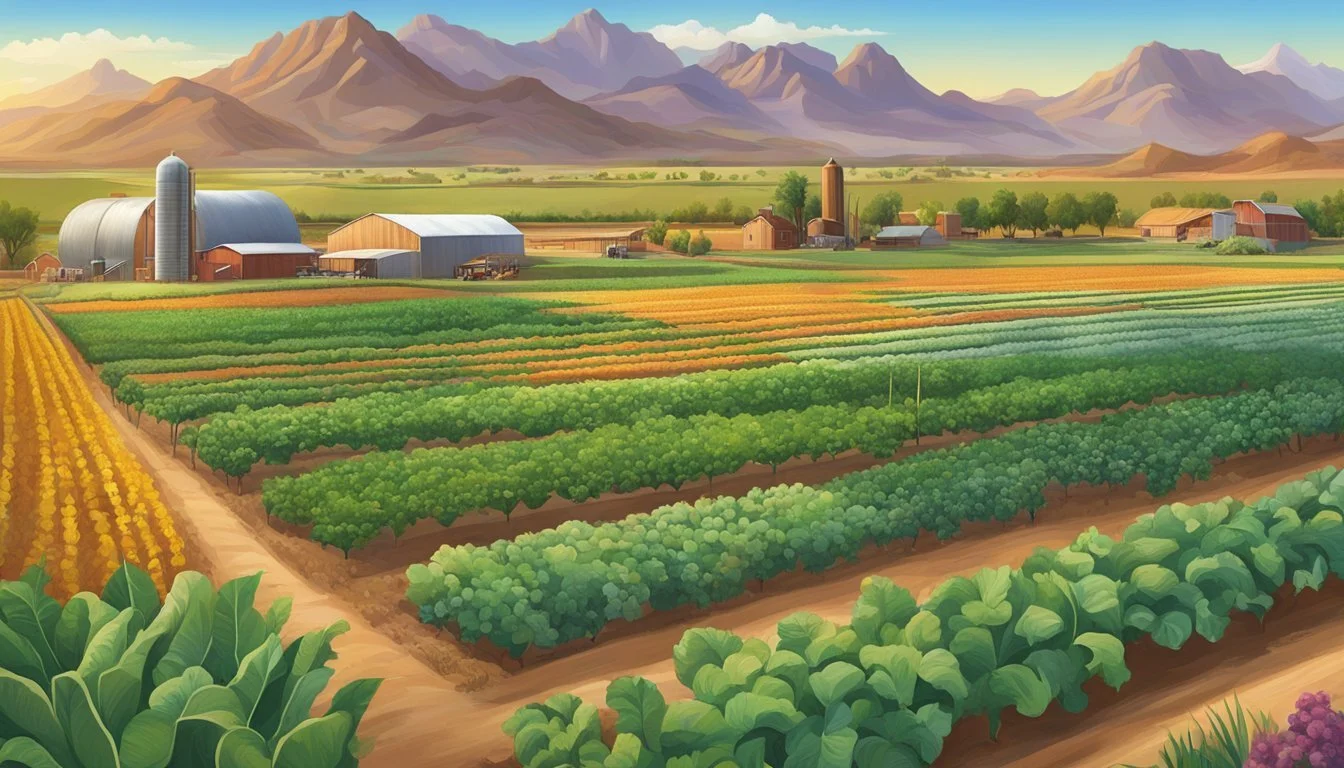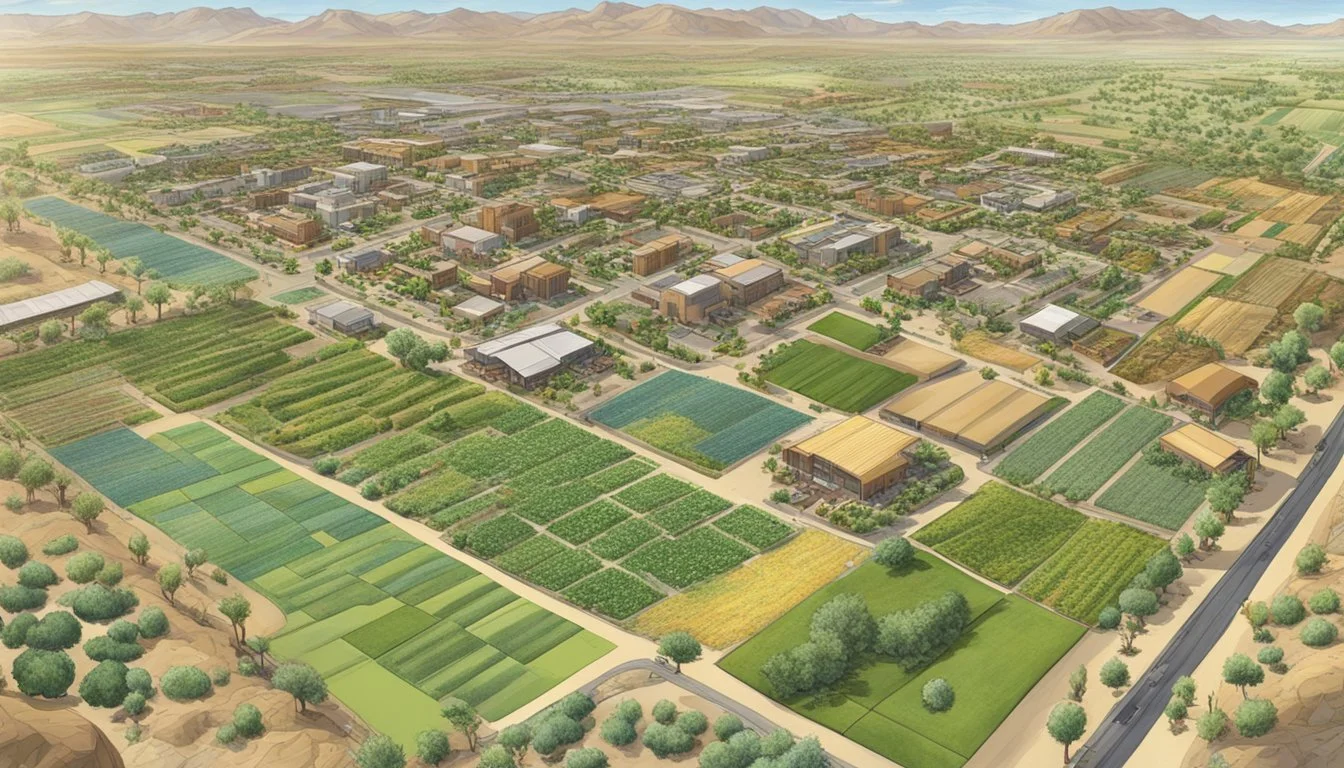Farming Communities in Arizona
Thriving Agriculture and Sustainable Practices
Farming communities in Arizona have long been integral to the state's economy and cultural heritage. From the vast irrigated pastures of Santa Cruz County to small farms in rural areas, these communities cultivate a variety of crops and livestock. Arizona’s diverse farming environment offers rich opportunities for agricultural pursuits.
Yuma, for instance, is renowned for its extensive farmlands, contributing significantly to the state's status as a leading producer of vegetables during winter. Similarly, Montosa Canyon Ranch exemplifies the large-scale, sophisticated operations that thrive in Arizona's agricultural sector. These ranches not only support local economies but also play a crucial role in national food production.
Beyond large ranches, Arizona's landscape is dotted with small farms and farmhouses, often family-owned. These smaller operations are pivotal in preserving agricultural traditions and providing fresh, local produce. The combination of large and small farming operations makes Arizona a unique and vital player in the nation’s agricultural landscape.
Historical Overview of Farming Communities in Arizona
Arizona's farming communities have a rich heritage shaped by their establishment and growth, and the unique agricultural practices they employed. These elements form the foundation of what has become a significant agricultural state.
Establishment and Growth
The first farming communities in Arizona emerged due to the efforts of early settlers who recognized the potential of the region's fertile land. By the early 20th century, groups like the Associated Farmers of Arizona were established to safeguard landowners' interests.
In 1935, farm-debt settlement committees played a vital role in helping farmers manage and resolve their debts, which was critical during the economic downturn of the Great Depression. The development of irrigation systems in areas such as the Salt River Valley enabled communities to thrive and expand agricultural production.
Early Agriculture Practices
Arizona's early agriculture hinged on effective irrigation to combat the region's arid climate. Indigenous peoples and later settlers implemented advanced irrigation techniques to ensure water supply for their crops.
Initially, common crops included corn and cotton, staples that adapted well to the local conditions. Careful management and innovative methods ensured sustainable yield and growth in the face of challenging environmental conditions.
Farmers adopted practices passed down through generations, melding traditional knowledge with modern advancements. This blending of methods created a resilient agricultural foundation that supported the farming communities throughout Arizona's history.
Contemporary Farming Communities
Arizona's farming communities showcase a blend of traditional practices and modern sustainability. Two notable examples include Agritopia, a model agrihood, and various urban farms that impact local food systems.
Agritopia: A Model Agrihood
Agritopia in Gilbert, Arizona, stands out as a prime example of a model agrihood. This planned community integrates urban farmland with residential areas, promoting a close-knit environment where residents have access to local produce. With The Farm at Agritopia, this community emphasizes organic farming methods to ensure sustainable agriculture practices.
Residents enjoy amenities such as community gardens, where they can grow their own vegetables and partake in farming activities. The focus on certified organic farms ensures that produce is free from harmful chemicals, promoting healthier food options. Agritopia exemplifies how urban planning and farming can coexist harmoniously, offering a blueprint for future developments.
Urban Farms and Their Impact
Urban farms in Arizona, particularly in cities like Phoenix and Tucson, play a crucial role in urban agriculture. These farms, often established on rooftops, vacant lots, or within community spaces, help to produce local, fresh produce. By utilizing innovative techniques such as hydroponics and aquaponics, urban farms maximize space and resources.
Moreover, urban farms contribute to food security by providing access to fresh vegetables and fruits in areas that might otherwise be food deserts. These initiatives encourage sustainable agriculture practices by minimizing the need for long-distance transportation, thus reducing the community’s carbon footprint. Urban farms also create educational opportunities, teaching residents about the importance of organic farming and sustainable living.
Agricultural Education and Community Outreach
Farming communities in Arizona benefit from extensive educational programs and community engagement initiatives that highlight both agricultural techniques and community wellness.
Educational Programs in Agriculture
The University of Arizona plays a pivotal role in agricultural education, offering programs tailored to different demographics.
4-H Youth Development is the largest youth-serving organization in the state, focusing on developing leadership, entrepreneurship, and problem-solving skills among young individuals. This initiative ensures that the next generation of farmers is well-prepared and resilient.
Veterans Agricultural Education provides targeted outreach to military veterans, addressing challenges such as lack of capital and land access. This program connects veterans with valuable resources like the USDA, equipping them with necessary agricultural knowledge and skills.
FFA Foundation supports agricultural education across Arizona, offering expanded learning and leadership opportunities. As a nonprofit entity, it relies on donations to enhance these programs.
Community Engagement and Wellness
Community engagement is essential for the success and well-being of Arizona's farming communities.
University of Arizona's Cooperative Extension collaborates with various community sectors to create programs addressing local needs. These initiatives cover areas like agriculture, youth development, and natural resources.
The Community Farm initiative highlights the involvement with the O'odham and Yaqui tribes, emphasizing the importance of diversity and inclusion. The university builds sustainable relationships with these Indigenous communities, enhancing agricultural practices while respecting cultural heritage.
Additionally, the Community Innovation Minor prepares students to apply academic principles to real-world problems, fostering economic, educational, and socio-political growth in local communities.
These outreach programs are integral in promoting wellness and resilience, providing valuable support and resources to various community members.
Local Economy and Sustainability
Local farming in Arizona plays a crucial role in bolstering the local economy and promoting sustainable agricultural practices. The impact extends from economic benefits to the adoption of environmentally friendly methods that ensure long-term viability.
Economic Benefits of Local Farming
Local farming boosts the state's economy by supporting farmers and creating employment. Farmers’ markets and co-ops enable producers to sell directly to consumers, fostering a community-oriented supply chain. These interactions help farmers retain a higher percentage of their sales, compared to wholesale or distant markets.
Local produce also attracts consumers seeking fresh and high-quality goods. The local food movement not only supports small-scale farmers but also keeps wealth within the community, circulating it back through local businesses and services.
Sustainable Practices and Organic Farming
Sustainable practices are essential for Arizona's farming communities due to water scarcity. Many farms implement water-conserving techniques such as drip irrigation and rainwater harvesting. This reduces wastage and ensures crops have a minimal environmental footprint.
Organic farms prioritize the use of natural fertilizers and pest control methods. By avoiding synthetic chemicals, they help preserve soil health and biodiversity. Certified organic farms adhere to strict standards, promoting cleaner and more sustainable farming methods that benefit both the environment and consumers seeking healthier produce.
Social Dynamics and Community Life
Farming communities in Arizona offer vibrant social dynamics and a unique communal life. The bonds formed in these neighborhoods revolve around shared interests in sustainable agriculture and a commitment to local food systems.
The Role of Community Gardens
Community gardens serve as crucial hubs for fostering social connections and neighborly interactions. Rhiba Farms in San Tan Valley is an example, where small-scale growers collaborate to cultivate nutrient-dense produce. These gardens often use collective efforts to grow non-commodity crops, microgreens, mushrooms, and even hemp.
Residents frequently share resources, tools, and knowledge, creating a cooperative environment. The physical layout of these gardens encourages daily communication, with pathways and communal areas designed to facilitate crossing paths. This setup not only supports agricultural productivity but also strengthens the sense of community.
Social Events and Farmer Markets
Social events and farmers' markets are central to community life in Arizona's farming towns. These gatherings provide platforms for local farmers to showcase their produce, such as the citrus harvested by Homegrown's team. They sold thousands of pounds of fruit at markets, contributing to the local economy and social fabric.
Markets act as gathering places where neighbors meet, share stories, and support each other. Events often include educational workshops on sustainable farming practices, fostering a culture of continuous learning. The atmosphere is typically friendly and interactive, enhancing the overall community spirit. These social events also provide opportunities for raising funds for communal projects, reinforcing the neighborhood’s interconnectedness and shared goals.
Cultivation Techniques and Crop Varieties
Arizona's diverse agricultural landscape supports a wide array of cultivation techniques and crop varieties, from fertile orchards to productive vegetable farms.
Orchards and Fruit Production
Orchards in Arizona are notable for producing a variety of fruits including apples, oranges, and peaches. The state's warm climate and ample sunshine are conducive to fruit cultivation, although irrigation is essential due to low rainfall.
Apple orchards thrive in areas like the Verde Valley and Cochise County. Orange groves are more common in regions such as Yuma and Maricopa counties, benefiting from the warmer temperatures. Peach trees also flourish in the state, often found in orchards in higher elevations where cooler temperatures prevail.
Effective orchard management practices include regular pruning, pest control, and scheduled irrigation. Growers often utilize drip irrigation to conserve water and ensure consistent moisture levels. These techniques help maximize fruit yield and quality, making Arizona orchards key contributors to the state’s agricultural output.
Vegetable Farming and Harvest Cycles
Vegetable farming in Arizona includes a variety of crops such as beans and squash, with a focus on both small-scale and commercial production. The state's climate allows for multiple harvest cycles, particularly in lower elevation areas where frost is less of a concern.
Common vegetable crops like beans and squash are typically planted in spring or fall, avoiding the extreme summer heat. Raised beds and mulching are popular techniques, helping maintain soil moisture and temperature. Crop rotation is essential to prevent soil depletion and manage pests naturally.
In hotter regions, shade cloths and hoop houses are employed to protect crops and extend the growing season. This technique allows for the production of high-quality vegetables almost year-round, catering to both local markets and export demands.
Innovations in Arizona Farming
Arizona's farming communities have adopted numerous innovations to address climate challenges and optimize agricultural productivity. These advancements focus on using technology to improve efficiency and building resilient farming systems to withstand harsh conditions.
Technological Advances in Agriculture
Farmers in Arizona utilize advanced agricultural technologies to combat arid conditions and water scarcity. Drip irrigation is commonplace, significantly reducing water waste by delivering water directly to the plant roots. In addition, controlled environment agriculture (CEA), including hydroponics and vertical farming, allows for year-round cultivation of crops like leafy greens and herbs in optimized conditions.
Drought-resistant crops are another innovation, helping farmers grow produce that can withstand high temperatures and low water availability. Farmers also employ shade structures to protect crops from intense sun, ensuring better yields. These innovations enhance the sustainability and productivity of Arizona's farming communities.
Building Resilient Farming Systems
Sustainable farming practices are vital in Arizona, given the state's climatic challenges. Urban farming projects like the 10,000 Urban Farms Project play a crucial role by promoting community-supported agriculture in urban areas, engaging residents in farming activities. This approach not only provides fresh produce but also strengthens community bonds.
Farms such as Rhiba Farms focus on non-commodity crops and nutrient-dense produce, utilizing land efficiently and sustainably. Furthermore, collaborative efforts among local organizations support climate-smart agriculture projects, creating models for sustainable farming that can be adapted to changing environmental conditions. These systems ensure long-term resilience and sustainability for Arizona's agricultural sector.
Farming Community Support and Resources
Farming communities in Arizona benefit from various support systems and resources designed to enhance their agricultural practices and sustain local economies. Key areas of support include community-backed initiatives such as Community-Supported Agriculture (CSA) programs.
Community-Supported Agriculture
Community-Supported Agriculture (CSA) programs play a significant role in supporting Arizona's farming communities. Through CSA programs, consumers subscribe to receive regular shares of a farm’s produce. This model provides farmers with upfront financial support, helping them plan crop production and manage resources effectively.
In Tucson, some CSA programs foster strong relationships between farms and local communities. Members share the risks and benefits of farming, creating a symbiotic relationship that enhances food security and builds trust.
Example Programs:
Tucson Community Supported Agriculture: Subscribers receive fresh, locally grown produce throughout the farming season.
IRC New Roots Farm: Participates in CSA to support refugee farmers and increase access to fresh food.
CSA programs also offer educational resources and communication platforms, such as Facebook groups, to promote knowledge sharing and community involvement. This mutual support enhances the resilience of farming communities across Arizona.
Culinary Culture and Farm-to-Table Movement
Arizona's culinary culture is deeply intertwined with the farm-to-table movement, highlighting the importance of local produce and innovative chefs. This movement not only supports local farmers but also enhances the dining experience across the state.
Restaurants and Local Culinary Delights
Arizona is home to several on-site restaurants that champion the farm-to-table concept. Quiessence in Phoenix, for example, sources ingredients from nearby farms and has been committed to this practice for over 15 years. Less than two hours north in Sedona, Elote Café by Chef Jeff Smedstad also emphasizes using fresh, local ingredients to create traditional Mexican dishes with a modern twist.
In Phoenix, a mobile app called Bites | Eat With Your Tribe connects chefs with urban farmers, allowing for unique in-home dining experiences. This app helps normalize the farm-to-table concept by making it accessible to a wider audience.
The Importance of Fresh Produce in Cuisine
Fresh produce is a cornerstone of Arizona’s farm-to-table movement. Locally sourced ingredients ensure that dishes are not only flavorful but also more nutritious. Chef-driven restaurants prioritize these high-quality ingredients to create dishes that reflect the region's agricultural richness.
Promoting local produce can stimulate the economy by supporting small-scale farmers and producers. This economic boost enhances financial stability within communities and creates job opportunities. The emphasis on fresh, local ingredients also fosters a sense of community, bringing people together through shared food experiences.
In conclusion, Arizona’s dedication to the farm-to-table movement enriches the state’s culinary culture, making it a prime destination for food enthusiasts.
Environmental and Ecosystem Considerations
Arizona's farming communities face unique environmental challenges. Key considerations include the impact of agriculture on local ecosystems and the interaction between biodiversity and farming practices.
Impact of Agriculture on Local Ecosystem
Agriculture in Arizona significantly influences local ecosystems. Farming activities can lead to water over-extraction, affecting local rivers and reservoirs. The Colorado River Basin, a major water source for the state, suffers from decreased water levels, necessitating careful water management strategies to prevent depletion.
Soil health is another crucial concern. Intensive farming can lead to soil erosion, reduced fertility, and loss of organic matter. Farmers in Arizona utilize methods like crop rotation, cover cropping, and reduced tillage to mitigate these effects and enhance soil structure and nutrients.
Air quality can also be impacted by agricultural activities. Dust from plowed fields and emissions from machinery contribute to air pollution, affecting both human health and wildlife.
Biodiversity and Agriculture
Farmers in the region are increasingly adopting practices that support biodiversity. This includes planting hedgerows and buffer strips, which provide habitats for beneficial insects, birds, and other wildlife. These natural barriers can also help in controlling pests and reducing the need for chemical pesticides.
The use of drought-resistant crops and diversified planting schedules supports resilience against environmental stressors. For example, growing a variety of citrus fruits, dates, and pecans not only caters to market demand but also enhances ecological stability.
Hydroponic and vertical farming techniques are contributing to biodiversity by allowing year-round farming while minimizing land use. These systems reduce habitat disruption and promote a more sustainable agricultural practice.
Tourism, Visitation and Education
Farming communities in Arizona offer unique opportunities for visitors to experience agricultural life firsthand. These activities provide educational insights and memorable experiences through various forms of agritourism.
Educational Tours and Agricultural Tourism
Educational tours in Arizona's farming communities focus on the integration of agriculture and learning. Local farms often host school trips, giving students hands-on experiences with farming practices.
Vineyards, such as those in Arizona's three major wine-growing regions, offer tours that educate visitors about viticulture.
Interactive farm visits are common, with activities such as you-pick fruit and vegetable harvesting. These tours emphasize the importance of local food production and sustainable farming practices.
Incorporating educational components helps increase awareness and appreciation of agriculture among all visitors.
Destination Farms and Local Attractions
Destination farms serve as significant local attractions, drawing tourists who seek unique experiences. Places like Red Rock Lavender in Concho provide scenic views and specialized crops, such as various lavender varieties.
Community-focused farms sometimes host events like weddings and festivals.
Visitors can also explore local culinary delights at attractions like The Coffee Shop, which emphasizes the local farming community's produce. Such venues highlight the deep connection between agriculture and local cuisine.
Wine-tasting sessions and farm-to-table dining experiences are popular among tourists. These activities not only boost tourism but also support the local economy by promoting direct sales from farms to visitors.
Engaging with these attractions ensures a memorable and educational experience for all visitors.
Urban Planning and Agricultural Spaces
Urban planning in Arizona is embracing innovative ways to integrate agricultural spaces within city landscapes, offering numerous benefits such as access to fresh produce and community engagement.
Integration of Farms in Urban Areas
Urban farms are becoming a cornerstone of city planning in Arizona. These farms, like those within the 10,000 Urban Farms Project in Phoenix, are designed to enhance local food production and sustainability. By utilizing vacant lots and rooftops, urban farms provide fresh produce to residents who might otherwise have limited access.
The farms also encourage community participation, fostering a sense of ownership and collaboration. Developers are increasingly incorporating agricultural spaces into new housing projects, transforming underused urban spaces into productive, green areas. These efforts support local economies, reduce food miles, and contribute to the urban ecosystem.
Architecture and Community Building Design
Designing urban spaces that seamlessly integrate agriculture requires innovative architectural styles. Agrihoods, such as those with 450 housing plots around 160 acres of farmland, are examples of balancing residential and agricultural needs. These communities blend organic farms with living and commercial spaces, promoting sustainability.
The architectural design must account for water efficiency, energy savings, and green spaces. In Phoenix, planners focus on using a small percentage of urban land for agriculture to meet sustainability goals. Community spaces, including gardens and shared facilities, are essential for fostering interaction and cooperation among residents, strengthening social ties within the urban fabric.










